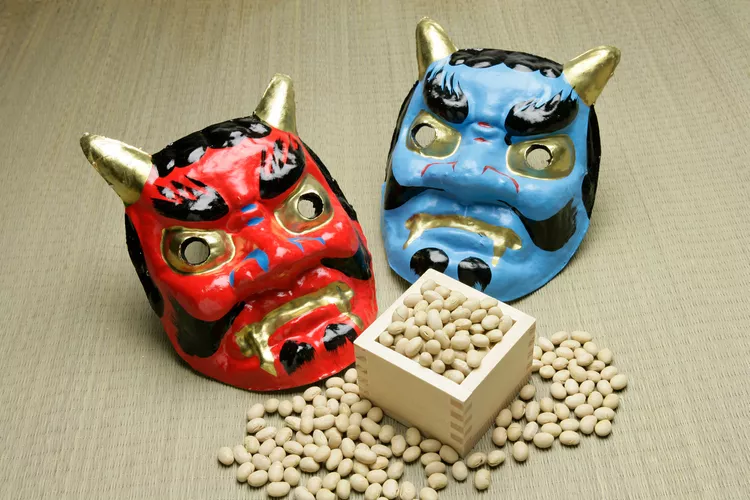Summary of Setsubun Festival
Setsubun: Japan’s Vibrant Bean-Throwing Festival
Introduction
Setsubun, Japan’s bean-throwing festival that celebrates the arrival of spring, is held annually on February 3 during the Haru Matsuri (Spring Festival). It marks a fresh start, similar to Lunar New Year celebrations worldwide, providing an opportunity to dispel evil spirits associated with illness and misfortune. And what is the best defense against these evil spirits? Beans! More specifically, roasted soybeans called fuku mame (fortune beans) are thrown outside to ward off negativity and to welcome good luck.
During Setsubun festivities, a senior male family member often dons a demon mask, playing the role of the antagonist. Families participate in the joyous chaos, throwing beans and collecting prizes from public celebrations, which have gained popularity and commercial endorsement. It is essential to note that, while Setsubun has its roots in traditional rituals, modern celebrations are increasingly commercialized with an abundance of merchandise available for purchase during the season.
:max_bytes(150000):strip_icc():format(webp)/japan-celebrates-the-end-of-winter---2924454-5c3f68c546e0fb0001d24a2b.jpg)
Is Setsubun a Public Holiday?
While Setsubun is celebrated widely across Japan, it is not officially recognized as a public holiday. However, it shares importance alongside other notable times such as Golden Week and the Emperor’s Birthday. On this day, many flock to Buddhist temples and Shinto shrines to participate in the throwing of roasted soybeans, a practice that symbolizes health and good fortune, whether at home or at these sacred sites.
Celebrating Setsubun at Home
Although public celebrations are lively, many families cherish the tradition of mame maki (bean throwing) in their own homes. Typically, any male family member born under the current zodiac sign assumes the ominous role of the ogre. If no one matches the zodiac, the eldest male takes on the character, wearing a fearsome mask and attempting to enter the household. As he does, family members joyfully hurl beans and chant, “Out with evil! In with fortune!” This playful interaction often elicits laughter, especially from children.
After the “demon” is evicted, family members close the door, symbolically saying, “Get out and stay out!” Subsequently, children may take turns wearing the mask for added fun. Those who prefer a less commercial experience can visit local shrines to witness traditional Setsubun celebrations. If you are traveling during this time, attending a nearby shrine can offer a more subdued atmosphere while respecting local worshippers.
:max_bytes(150000):strip_icc():format(webp)/japan-celebrates-the-coming-of-spring-with-the-bean-scattering-ceremony-84598811-5c3f67ebc9e77c0001c0937b.jpg)
Bean Throwing in Public
Public bean-throwing ceremonies, known as mame maki, see participants shout phrases like “oni wa soto!” (get out demons!) and “fuku wa uchi!” (come in happiness). Nowadays, these events are often grand spectacles, featuring sumo wrestlers and numerous celebrities. Additionally, participants can expect to collect throwing prizes that range from candy to envelopes containing money, creating high energy in the crowds.
Eating the Setsubun Beans
Although peanuts may make an appearance, the true traditional choice remains fuku mame (roasted soybeans). As part of the festival rituals, it’s customary for individuals to consume one bean for each year of their life, plus an additional bean for extra health in the new year. This practice originated in the Kansai region and has since spread across Japan through various vendors of the soybeans.
Other Setsubun Traditions
Historically regarded as a sort of New Year’s Eve in Japan, Setsubun has been celebrated in various forms since the 1300s, having been introduced by the Chinese in the 8th century. Beyond the popular practice of throwing beans, some families still observe the tradition of yaikagashi, which involves hanging sardine heads and holly leaves above doorways to thwart unwanted spirits.
In keeping with tradition, Eho-maki sushi rolls are consumed during Setsubun, representing good fortune. Unlike typical sushi, these rolls are eaten whole to avoid cutting, which is considered unlucky during the Lunar New Year. Additionally, hot ginger sake is often enjoyed for its warming properties. A strict observance means families eat in silence while facing the direction associated with good fortune for the new year, decided by the zodiac symbol.
Earlier customs included fasting, rigorous rituals at shrines, and even bringing outdoor tools indoors to ward off unruly spirits. Interestingly, geisha maintain these age-old practices by donning disguises or dressing as men during their encounters with clients on Setsubun.




